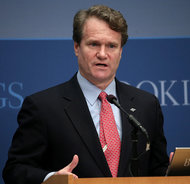As of the end of June, refinancing activity represented 64 percent of all mortgage applications, the lowest volume since May 2011, according to the Mortgage Bankers Association.
The rise in rates by “better than a point” since early May has effectively killed off a lot of the refinancing business, in what amounts to a “purely an interest-rate-driven decision,” said Keith T. Gumbinger, the vice president of HSH.com, a financial publisher. But getting into a new mortgage still makes sense for some categories of homeowners.
The most obvious candidates are borrowers whose rates are 5.5 percent or higher. The rate for a 30-year fixed-rate mortgage has lately hovered around 4.5 percent; the 15-year fixed rate is around 3.5 percent.
Borrowers who couldn’t refinance when rates were lower because their homes were barely worth what they owe may be better positioned now, Mr. Gumbinger said. “Maybe you didn’t have a deep enough equity position before,” he said, “but with home prices rising — in some places, up 10 percent over last year — market forces may be more favorable for you, even with the rise in rates.”
He noted that although the federal Home Affordable Refinance Program, or HARP, was set up to help underwater borrowers refinance, not everyone qualifies. So some borrowers could still be “sitting on a loan in the sixes or sevens.”
Borrowers with a variable-rate mortgage that is about to go up might consider refinancing if they plan to stay in the house for a long time, said Gary Schatsky, a financial adviser and lawyer in New York. Also, those with “a good chunk” of their equity in a home equity line of credit, and no likelihood of paying it off in the short term, could possibly benefit from consolidating, depending on the closing costs, he added.
If refinancing just doesn’t make sense, there are other ways to reduce the amount of interest paid. One strategy is to pay more toward the principal every month than required, lowering the balance upon which interest is figured.
HSH.com offers two online calculators to help borrowers figure out how much they can save. The prepayment calculator asks how much you can afford to send in each month, and then calculates how much interest you would save over the life of the loan. The lower-rate calculator asks what interest rate you would prefer to your current rate, and then calculates how much you would need to prepay each month to save an equivalent amount of interest.
Borrowers considering a prepayment strategy should remember, however, that they will lose some liquidity. They might also think about whether the money might be better applied elsewhere (i.e., life insurance and cash reserves).
“You have to not need the money for a prolonged time in the future,” Mr. Schatsky said. “And if you can afford the larger payments, you might want to look at a 15-year mortgage because shorter-term rates are still extraordinarily low.”
Some lenders also offer biweekly payment programs. By having half of your mortgage payment deducted every two weeks, instead of making one monthly payment, you will effectively make an extra month’s payment every year.
“If you start doing this at the beginning of the loan,” Mr. Gumbinger said, “you can trim your loan down to 23 years.” But many lenders charge fees for automated biweekly billing; a disciplined borrower could achieve the same goal by simply cutting one extra check each year, he pointed out.

Article source: http://www.nytimes.com/2013/07/21/realestate/refinancing-despite-a-rate-rise.html?partner=rss&emc=rss





